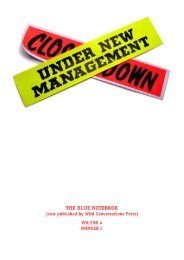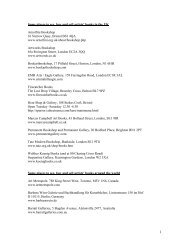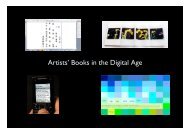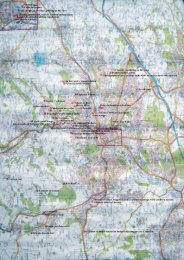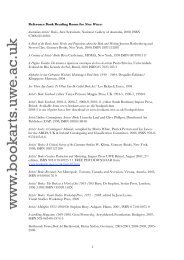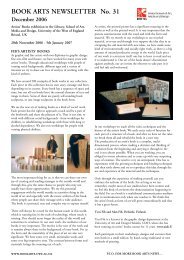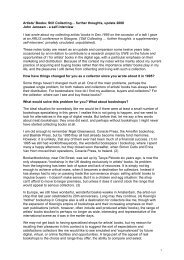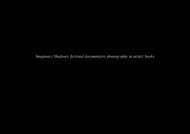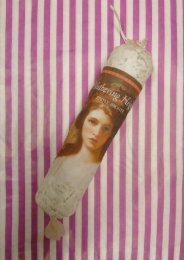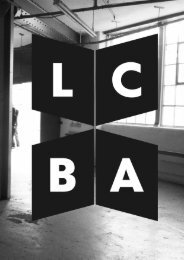Artist's Book Yearbook 2003-2005 - Book Arts - University of the ...
Artist's Book Yearbook 2003-2005 - Book Arts - University of the ...
Artist's Book Yearbook 2003-2005 - Book Arts - University of the ...
You also want an ePaper? Increase the reach of your titles
YUMPU automatically turns print PDFs into web optimized ePapers that Google loves.
Editions F. Despalles was started 20 years ago by<br />
Françoise Despalles and Johannes Strugalla in<br />
Paris (France) and Mainz (Germany) as a<br />
printing, publishing and distribution house for<br />
graphics, paperworks and artists’ books. At <strong>the</strong><br />
same time, Editions F. Despalles serves as a<br />
bridge between France and Germany,<br />
publishing authors and artists who might be<br />
quite known at home but would easily remain<br />
unknown in <strong>the</strong> o<strong>the</strong>r country. Bilingual<br />
editions are a speciality <strong>of</strong> Editions F. Despalles’<br />
programme. In addition, Johannes Strugalla is<br />
an artist, typographer, and author himself.<br />
Ziemlich gedichtkopfkissen is a text by <strong>the</strong> Austrian<br />
author Friederike Mayröcker, published here<br />
for <strong>the</strong> first time, including <strong>the</strong> first translation<br />
into French (presque oreiller poème). The unusual<br />
images Friederike Mayröcker creates in her<br />
texts are accompanied by monochrome<br />
etchings by Monique Frydman that point<br />
towards what lies beyond words. The<br />
typography by Johannes Strugalla transforms<br />
<strong>the</strong> texts into visual structures – readable<br />
images that do not illustrate <strong>the</strong> text, but add<br />
ano<strong>the</strong>r dimension.<br />
Zinnober/Cinabre is a book with images and texts<br />
by Johannes Strugalla. In a meditative mood,<br />
Johannes Strugalla reduces his visual<br />
vocabulary to black vertical lines, drawn with<br />
a bamboo pen, creating a certain rhythm and<br />
tension. These lines meet with pages <strong>of</strong> pure<br />
rich vermillion and yellow. The texts were<br />
written parallel to <strong>the</strong> visual work in French<br />
and German. Here <strong>the</strong> artist/author plays with<br />
linking different levels <strong>of</strong> reality.<br />
The next artist <strong>of</strong> 13 + is Barbara Fahrner.<br />
She has been working with artists’ books for 23<br />
years. She is an artist, an author, a philosopher,<br />
a scholar. To her, writing is drawing, drawing is<br />
writing. In her work, text and image cannot be<br />
separated. For Leuchte Barbara Fahrner took a<br />
text by Georg Büchner, Lenz and re-wrote it,<br />
using a method called “oulipo” (a term that<br />
refers to “Ouvroir de la littérature potentielle”:<br />
workshop for potential literature). In doing<br />
this, every word is substituted by ano<strong>the</strong>r,<br />
following certain rules, and <strong>the</strong> new text<br />
generated creates ano<strong>the</strong>r sense that sort <strong>of</strong> lies<br />
behind <strong>the</strong> original text. (The book includes a<br />
dictionary to re-translate to <strong>the</strong> original text.)<br />
56<br />
Leuchte Barbara Fahrner<br />
The project which Barbara Fahrner has realised<br />
during <strong>the</strong> last 5 years with <strong>the</strong> help <strong>of</strong> her son,<br />
Markus Fahrner, and his wife, Fitnad Aboudye -<br />
Fahrner, is as large as manifold. The title Zweite<br />
Enzyklopädie von Tlön (Second Encyclopaedia <strong>of</strong><br />
Tlön) refers to a novel by Jorge Luis Borges,<br />
where he says: “In a hundred years time some<br />
one will find <strong>the</strong> hundred volumes <strong>of</strong> <strong>the</strong><br />
Second Encyclopaedia <strong>of</strong> Tlön”.<br />
Zweite Enzyklopädie von Tlön Barbara Fahrner<br />
Barbara Fahrner’s Encyclopaedia shows <strong>the</strong><br />
whole range <strong>of</strong> her thoughts, material, and<br />
artistic techniques she uses: little sheets <strong>of</strong><br />
paper with notes and sketches, long texts<br />
written by herself, quotations from different<br />
authors throughout <strong>the</strong> ages, exquisite<br />
drawings and prints on precious papers, hand<br />
writing and type setting, all sorts <strong>of</strong> collage,<br />
kept in envelopes and document files. This<br />
encyclopedia does not pretend to include <strong>the</strong><br />
whole world, although it shows <strong>the</strong> world’s<br />
complexity in every part. It is not a bibliophile<br />
beautiful book. Instead, it is a presentation <strong>of</strong> a<br />
concept <strong>of</strong> world perception, that asks and<br />
demands from <strong>the</strong> reader a new understanding<br />
<strong>of</strong> <strong>the</strong> traditional, re-reading what seemed to be<br />
well known, experimenting with <strong>the</strong> order <strong>of</strong><br />
image and text.




